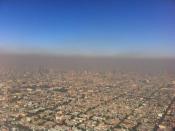Photochemical smog contains a mixture of primary and secondary pollutants. Primary pollutants are those which have been released directly into the photochemical smog present in the atmosphere, by the combustion of fuels; example: CO. Secondary pollutants are those which have been formed when the primary pollutant of the photochemical smog undergoes further reaction, by the heat of the sun; example: ozone. NOx and NO2 are the main primary and secondary pollutants produced respectively from motor vehicles.
A coal fired power station has three main inputs, coal, cooling water to condense steam from the boilers and very pure water for the use in the steam turbine. The main primary pollutants from a coal fired power stations are CO2, SOx & NOx
- Carbon from coal and oxygen from air produces CO2 when coal combusts.
- When sulphur compounds present in coal burns, they are converted to oxides of sulphur.
- The powder of coal is mixed with air; thus producing oxides of nitrogen, where N and O2 are from air.
The favourable condition for a photochemical smog to form is high pressure in low troposphere. Such conditions usually give rise to still air, where little mixing with high altitude air is there. The pollutants are therefore trapped near the ground. Sunlight can also help the formation of photochemical smog. Light prevailing wind transports polluted air from urban to rural areas, thus causing high ozone concentration in rural areas. Ozone is involved in a series of reaction that produces the photochemical smog; its concentration is increased during smog formation. In the troposphere
NO2 hv NO + O
the action of sunlight on NO2 molecules produces NO and O
O2 + O O3
The O2 atoms from the air react with the O formed to produce O3 ozone; thus increasing the ozone concentration.


